April 19, 2016 Ryukyu Shimpo
The severity of environmental pollution from U.S. military bases in Okinawa, and the deep secrecy with which this is handled, have been illuminated once again. Okinawan citizens’ stress from the concerns connected to bearing an overlarge share of the bases makes this an even more disorderly situation. Chemical substance control within U.S. base compounds is in chaos.
Stricter compliance to U.S. base regulations and systematic implementation in terms of toxic substance control when contamination occurs should be strongly encouraged. Moreover, it is essential that the U.S.-Japan Status of Forces Agreement (SOFA) be revised, and the privileged status the U.S. Armed Forces receive from it be curtailed.
In an inspection of Kadena Air Base’s 500 transformers, which were suspected of leaking polychlorinated biphenyl (PCB), only about half of the transformers were found to be in operation. However, even those in use were not examined for leakage and are being left to their own devices.
Furthermore, between 1998 and 2015 a total of 40,000 liters of jet fuel and other substances were leaked in multiple incidents. In a report to the Japanese government, only 23 of the 206 incidents that occurred between 2010 and 2014 were disclosed.
Even though information was withheld from the report, journalist Jon Mitchell acquired email records and other documentation under the Freedom of Information Act, and disclosed the missing information.
It is appropriate to say that U.S. bases in Okinawa are lawless areas, supportive of environmental conservation in words alone, but not in action. Were such an occurrence to take place domestically on U.S. bases, without a doubt the Environmental Protection Agency (EPA) would take it as a serious matter, initiate an investigation, and make the problem public.
Both the U.S. and Japanese governments claim that the Japan Environmental Governing Standards (JEGS) used on U.S. military bases in Japan apply the more stringent criteria from the U.S. or Japan, and are aimed at preventing pollution. However, the current circumstances demonstrate that the JEGS are not functioning as claimed, due to the slack with which the bases are being run.
Many environmental pollution problems have piled up and persist on U.S. military bases.
First of all, Japan’s domestic laws do not apply on U.S. bases, as local governments are not allowed entrance onto a base when a contamination incident occurs. The U.S. Armed Forces are exonerated from the responsibility of restoring land to its original condition upon returning it to Japanese control. It is evident that there is a vicious cycle of the U.S. Armed Forces not working to deter pollution.
In September 2015 the governments of the U.S. and Japan concluded the Supplemental Agreement on the Environment of the SOFA. However, the agreement gives the U.S. Armed Forces the discretion to choose whether or not to comply. Under the agreement the Armed Forces are not obliged to accept a local government’s request to enter a base for inspection purposes.
In Okinawa, the military does not officially disclose records of the use of toxic substances or the reality of toxic substance oversight on the bases, which is common practice on bases in the United States.
The double standards held by U.S.-Japan that work against residents living around the bases and local governments are unpardonable. To stop this hypocrisy, there is no choice but to carry out revision of the U.S.-Japan SOFA, and to impose the duty of preventing pollution onto the U.S. Armed Forces.
(English translation by T&CT and Erin Jones)
Go to Japanese
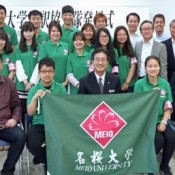
April 17, 2016 Ryukyu Shimpo
On April 11, Meio University formed a team of volunteer interpreters to serve as guide interpreters at local events. The team is composed of foreign exchange students and students studying foreign languages. A ceremony was held to mark the team’s formation at the Hokubu Center for Life-long Learning in Nago City. Seventeen exchange students from China, wearing matching green hats and T-shirts, expressed their enthusiasm for participating in the initiative. According to a representative of Meio University, this is the first time a university in Okinawa has launched this sort of initiative, and one of the only examples nationwide.
Many marathons and other events are held in the northern area of Okinawa, and recently, there has been an increase of tourists from overseas attending such events. Members of the guide interpreter team will act as guides for tourists by providing interpretation as a form of engagement in local activities. Currently, Chinese is the only language offered, but going forward, the university hopes to form teams of English, Korean, Spanish, and Portuguese interpreters, and will continually recruit new participants.
The volunteer teams will also work to contribute to the improvement of language skills of local residents by holding many language study courses at Meio University’s extension center.
At the ceremony, Meio University President Katsunori Yamazato expressed his enthusiasm for the initiative, saying, “We want to respond to the needs of the community. I have high hopes for our students.” Jinjing Liu, a graduate student at Meio University and member of the interpreting team, expressed her resolution, saying, “I want to do my best to help the community.”
(English translation by T&CT and Sandi Aritza)
Go to Japanese
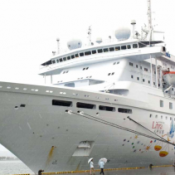
April 14, 2016 Ryukyu Shimpo
A cruise ship named “Superstar Libra” from Hong Kong cruise company, Star Cruises, docked at the Nakagusuku Port for the first time on April 13. The ship weighs 42,285 ton. This is the first cruise ship to stop there for five years. About 1,000 passengers and crew staff from China visited Churaumi Aquarium and Shurijo Castle, travelling on tour buses.
Nakagusuku Port Cruise Promotion Liaison Council, consisting of Okinawa City, Uruma City, Kitanakagusuku Village, and other groups, held a ceremony at the port to welcome the visitors. As berthing in Naha City has been difficult due to an increase of cruise ships, Nakagusuku Port is being promoted as an alternative and this is expected to bring economic benefit to the central part of the island.
The “Libra” is scheduled to dock at the port a total of 18 times by September. Okinawa City Mayor Sachio Kuwae welcomed the cruise ship, saying, “I would like the visitors to experience the attractions of the central part of the island such as Katsuren and Nakagusuku castle ruins, as well as Tonan Shokubutsu Botanical Park. We would like to make our best effort to arrange our support system to welcome the visitors.”
(English translation by T&CT and Sayaka Sakuma)
Go to Japanese
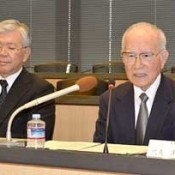
April 15, 2016 Ryukyu Shimpo
On April 14, the University Consortium Okinawa, which consists of eleven higher education institutions including public and private colleges and universities, held a press conference at the Okinawa Institute of Science and Technology (OIST) in Onna Village. They announced the establishment of a “Student Volunteer Center for Children” that sends students out to support the learning and daily life of children in households suffering from financial difficulty. The head office will be located at the University of the Ryukyus.
The center will arrange for volunteer college students to support children in their learning and art activities at the Children’s Dining and Learning-Support Schools in Okinawa. The Consortium is still to discuss and decide on volunteer partners, volunteer training, and the number of volunteer students. The center aims to go into full-scale operation from May.
The center will use subsidies from the Okinawa Child Poverty Countermeasure Projects set up by the Cabinet Office. The University Consortium Okinawa, which received a government commission for the initiative, will manage the project.
Director of the Consortium Eiki Senaha said, “This is the first attempt (at such a project). We will set out first and then discuss details gradually.”
Cabinet Councilor Masahiko Furuya said, “To keep students engaged in volunteering, it is important to ask private companies for financial help and a secure paid-in assistant system. We would like to see that happen in the future.”
(English translation by T&CT and Megumi Chibana)
Go to Japanese
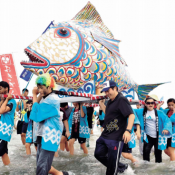
April 11, 2016 Ryukyu Shimpo
For three days from April 9, which is March 3 on the Chinese calendar, Sanguwacha was held on Henza Island in Uruma City. Residents prayed for safe navigation and a good season’s fishing. On April 10, Todaiyu and Nanzamooi were held to kick off the season with a prayer for ocean safety, a good season’s fishing, and the good health of the islanders.
At a sacred square called Chonohama, kaminchu (sacred women) sang a song to devote Lethrinus nebulosus to noro or female oracles. Women stuffed the fish with grains and then held them to the sky. When the women started to dance, residents and spectators rushed to release the shutter to them.
The Nanzamooi event was led by the standard-bearer, who stated, “For the celebration of a good catch”.
Junior high school students carried a hand-made portable shrine with loaded with the fishes. They paraded for about 700 meters along the coastline to the rock Island of Nanza. Tomio Matsuda, the head of the residents’ association, came ashore to pray for a great catch of fish, facing the direction of Nirai Kanai, a mythical place in the Ryukyu culture.
(English translation by T&CT)
Go to Japanese
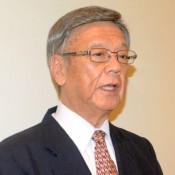
April 13, 2016 Ryukyu Shimpo
As a member of the Association for the Promotion of International Trade, Japan, Okinawa Governor Takeshi Onaga stayed in Beijing from April 10 to 13. On his return to Okinawa, Onaga said, “I feel there is dynamism in Asia. I expect an increase in exports of Okinawan products to China and also expect more Okinawan companies in such fields as IT and tourism to tap into the Chinese market.” Onaga visited China as a member of the association for the second time, following his first visit last year.
On April 11, Onaga met Gao Hucheng, Commerce Minister of China and then met Wang Yang, one of the four Vice Premiers of China on April 12. Onaga attended a round-table conference with Chinese trade organizations. At the conference, Onaga said he planned to accelerate exports of Okinawan and Japanese products to China by using Okinawa as a logistic hub. He stressed the importance of streamlining and speeding up customs clearing and quarantine in the Fujian Free Trade Zone. Onaga also suggested that Chinese companies create industrial clusters in Okinawa and promote economic exchange with the prefecture.
(English translation by T&CT)
Go to Japanese
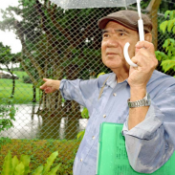
April 18, Ryukyu Shimpo
On April 17, at graves within U.S. Marine Corp Air Station Futenma, Ginowan, residents held the Shimi Festival to celebrate their ancestral spirits.
After getting permission from the authorities, about 490 people visited their ancestors’ graves.
The Futenma airfield remains 20 years after the governments of Japan and the United States agreed to close it and return lands to the owners. For the annual Shimi Festival, residents have to get the permission from the U.S. Marine Corps to visit their ancestors’ graves.
Seizen Ameku, 76, and about 20 of his family members gathered at the ancestors’ grave.
Ameku revealed his mixed feelings. “We family members gathered at the grave. It was only in order to tell our ancestors what we have been doing lately. Why do we need to get the permission from the U.S. marines?” he said.
According to Ameku, when he was a child, the residents could visit the grave freely because there was no fence between the base and local residential areas.
When he came back from out of Okinawa after finishing his school life in 1960s, fences surrounded the base. The U.S. military now requires the local residents to request permission to visit the graves.
Ameku said he had been repeatedly asked to identify himself by the military officials.
One of the family members was followed by a Japanese security guard employed by the U.S. military all the way to in front of the grave from gate of the base.
“American soldiers go out and come into the base freely. Why aren’t Okinawan citizens allowed to do it?” Ameku said.
(Translation by T&CT)
Go to Japanese
April 13, 2016 Ryukyu Shimpo
By Takumi Takimoto
The China Aging Development Foundation (CADF), which supports care for the elderly in China, and the Japanese Association for the Promotion of International Trade (JAPIT) are collaborating to hasten establishment of an Okinawa International Advanced Caregiving Technology Center in Nanjo City, with a goal of spreading caregiving technology to China. The two organizations made this news public on April 12, making use of Okinawa’s status as a national strategic special zone. Trainees from China will come to the Center in Okinawa to learn about Japan’s caregiving technology, and there is a plan to establish training centers in about 300 towns and cities around China in an attempt to spread this technology throughout China.
A 4,300 square-meter site in Maegawa, Nanjo City is the planned site for the establishment and of rehabilitation facilities, training facilities and home-visiting caregiving services. A special purpose company started up in June last year, and it purchased the plot of land in Nanjo City in March this year. Back in June the two organizations concluded the basic plan for the Center, upon which they will model the centers within China.
Officials of the JAPIT selected Okinawa as the site for the Center due to its central location within Asia and its status as a national strategic special zone. The JAPIT and CADF announced their plan at a joint gathering on April 12.
(English translation by T&CT and Erin Jones)
Go to Japanese
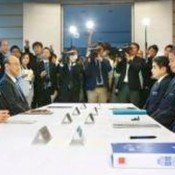
April 14, 2016 Ryukyu Shimpo
On April 14, the representatives from the Okinawan prefectural government and the Japanese government met at the Prime Minister’s office in Tokyo. Their meeting marked the first of a series of working-level talks agreed upon as part of the court settlement over the construction of a new U.S. military base in Henoko, Nago as part of the relocation of U.S. Marine Corps Air Station (MCAS) Futenma. The meeting covered the details of what exactly will be entailed by the cancellation of construction. Japanese government representatives said they will look into removing the floats put up in the bay around Henoko to demarcate the temporary restricted zone established to facilitate the construction.
At the working meeting, Okinawa prefectural government representatives made four requests: (1) The removal of floats, buoys, and oil fences in the bay around Henoko; (2) Removal of temporary roads used for construction; (3) Suspension of barracks construction on land; and (4) swift convention of a meeting to discuss ways to reduce the burden posed on Okinawa by MCAS Futenma. Of these requests, the Japanese government expressed willingness to comply with the removal of floats and convention of a meeting regarding Futenma.
Meanwhile, the Japanese government asked Okinawa to cooperate in the removal of protest tents blocking the road leading to construction sites in the U.S. Northern Training Area, where new helipads are being built to replace those set to be returned along with a portion of the training area. The Okinawa prefectural government expressed its intention to follow written instructions from the central government to deal with the matter administratively.
The working meetings are being held in parallel with high-level meetings between Okinawan Governor Takeshi Onaga, Chief Cabinet Secretary Yoshihide Suga, and other officials. Representing Okinawa at the working meetings are Vice Governor Mitsuo Ageda and the head of the Executive Office of the Governor. The Japanese government is represented by Deputy Chief Cabinet Secretary Kazuhiro Sugita and the director of the Ministry of Justice’s Litigation Bureau.
After the meeting, Vice Governor Ageda said that the government’s willingness to remove the floats marked a somewhat positive development.
The next working meeting is set to be held in Okinawa sometime in May.
(English translation by T&CT and Sandi Aritza)
Go to Japan
April 9, 2016 Ryukyu Shimpo
The largest travel website in the world, Trip Advisor, released 2015 data on Japan’s most popular sightseeing destinations among Japanese people and visitors from abroad, based on user reviews of any language on the site.
The highest-ranking sightseeing destination within Okinawa was found to be Nishihama Beach (Taketomi) among Japanese people, and Churaumi Aquarium (Motobu) among foreign travelers.
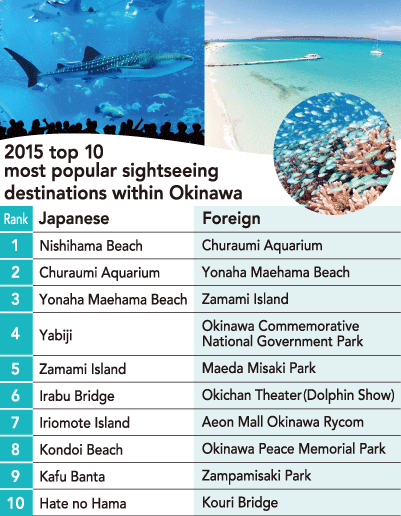
Based on user reviews on Trip Advisor in 2015 the second and third most popular tourist destinations for Japanese travelers are Churaumi Aquarium and Yonaha Maehama Beach (Miyako), respectively. For visitors from abroad, Yonaha Maehama Beach is ranked as the second most popular and Zamami Island (Zamami) as the third most popular tourist sites.
When observing the number of reviews submitted by travelers to each prefecture within Japan, reviews on sightseeing destinations in Okinawa account for 6.7 percent of all reviews by Japanese travelers, ranking it third. However, reviews from foreign travelers only rank it in seventh at 3.4 percent.
The prefectures with the most reviewed sites on Trip Advisor among Japanese travelers are Tokyo at 19.1 percent and Hokkaido at 7.8 percent, with Okinawa ranked third. Reviews by tourists from abroad also focus in Tokyo at 32 percent, followed by Kyoto at 15.7 percent, and Osaka at 10.3 percent.
(English translation by T&CT and Erin Jones)
Go to Japanese
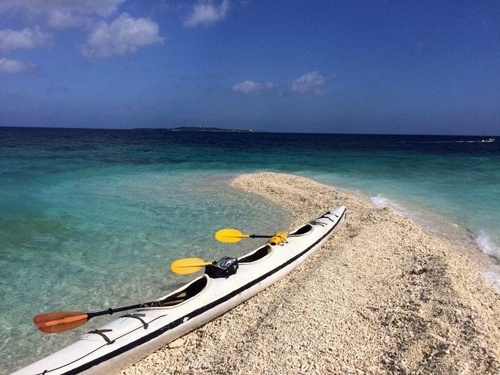








 Webcam(Kokusai Street)
Webcam(Kokusai Street)


